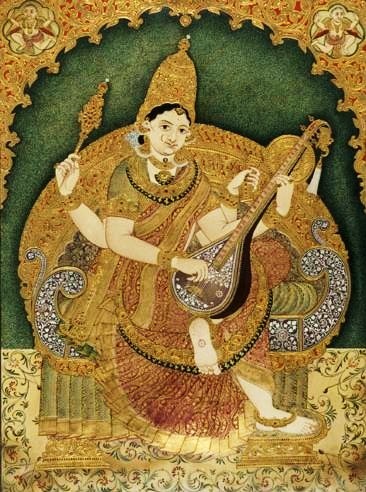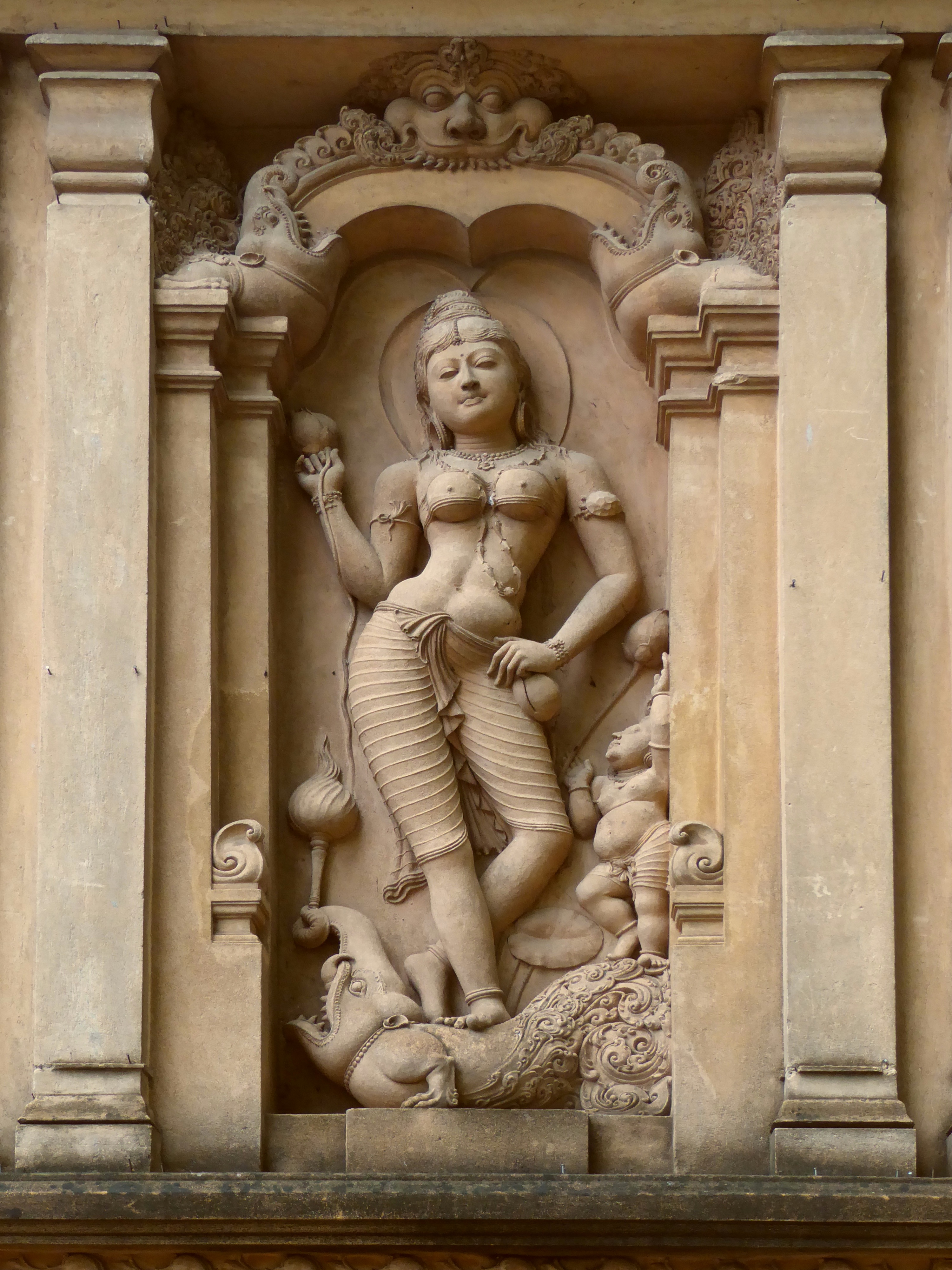|
Saraswati
Saraswati (, ), also spelled as Sarasvati, is one of the principal Devi, goddesses in Hinduism, revered as the goddess of knowledge, education, learning, arts, speech, poetry, music, purification, language and culture. Together with the goddesses Lakshmi and Parvati, she forms the trinity of chief goddesses, known as the Tridevi. Sarasvati is a pan-Indian deity, venerated not only in Hinduism but also in Jainism and Buddhism.Ludvik (2007), pp. 1, 11. She is one of the prominent goddesses in the Historical Vedic religion, Vedic tradition (1500 to 500 BCE) who retains her significance in later Hinduism. In the Vedas, her characteristics and attributes are closely connected with the Sarasvati River, making her one of the earliest examples of a Rivers in Hinduism, river goddess in Indian tradition. As a deity associated with a river, Sarasvati is revered for her dual abilities to purify and to nurture fertility. In later Vedic literature, particularly the Brahmanas, Sarasvati is i ... [...More Info...] [...Related Items...] OR: [Wikipedia] [Google] [Baidu] |
Sarasvati River
The Sarasvati River () is a Apotheosis, deified myth, mythological Rigvedic rivers, river first mentioned in the Rigveda and later in Vedas, Vedic and post-Vedic texts. It played an important role in the Historical Vedic religion, Vedic religion, appearing in all but the fourth book of the Rigveda. As a physical river, in the oldest texts of the Rigveda it is described as a "great and holy river in north-western Indian subcontinent, India," but in the middle and late Rigvedic books it is described as a small river ending in "a terminal lake (samudra)." As the goddess Saraswati, Sarasvati, the other referent for the term "Sarasvati" which developed into an independent identity in post-Vedic times, the river is also described as a powerful river and mighty flood. The Sarasvati is also considered by Hindus to exist in a Metaphysics, metaphysical form, in which it formed a confluence with the sacred rivers Ganges, Ganga and Yamuna, at the Triveni Sangam. According to Michael Witzel, ... [...More Info...] [...Related Items...] OR: [Wikipedia] [Google] [Baidu] |
Veena
The ''veena'', also spelled ''vina'' ( IAST: vīṇā), is any of various chordophone instruments from the Indian subcontinent. Ancient musical instruments evolved into many variations, such as lutes, zithers and arched harps.Vina: Musical Instrument Encyclopædia Britannica (2010) The many regional designs have different names such as the '' Rudra veena'', the '''', the '' Vichitra veena'' and others. The North Indian ''rudra veena'', used in |
Sarasvati Puja
Vasant Panchami , also rendered Vasanta Panchami and Saraswati Puja in honour of the Hindu goddess Saraswati, is a festival that marks the preparation for the arrival of spring. The festival is celebrated in Indian religions in different ways depending on the region. Vasant Panchami also marks the start of preparation for Holika and Holi, which take place forty days later. The Vasant Utsava (festival) on Panchami is celebrated forty days before spring, because any season's transition period is 40 days, and after that, the season comes into full bloom. Nomenclature and date Vasant Panchami is celebrated every year on the fifth day of the bright half of the Hindu lunisolar calendar month of Magha, which typically falls in late January or February. Spring is known as the "King of all Seasons", so the festival commences forty days in advance. It is generally winter-like in northern India, and more spring-like in central and western parts of India on Vasant Panchami, which gives ... [...More Info...] [...Related Items...] OR: [Wikipedia] [Google] [Baidu] |
Rivers In Hinduism
In Hinduism, rivers are often personified as deities. In the Rigveda, there are mentions of holy rivers such as the Sarasvati. The river Ganges is considered to be most sacred, and is also personified as the goddess Ganga. Most of the rivers are represented in female form, with the notable exception of Brahmaputra, which is considered to be male. The most significant rivers in the faith are the ''Saptanadi'' and which includes the Ganges, Yamuna, Sindhu, Narmada, Godavari, Krishna, and Kaveri. Deities Ganga The Vedas and Puranas mention the river Ganges to be the most sacred river. In some legends, the goddess Ganga is daughter of Himavan (the personification of the Himalayas) and Menavati (an ''apsara''). She is the sister of the mother goddess, Parvati. She is the goddess of purity and purification, as people believe that bathing in the Ganges removes sins and helps in gaining ''moksha''. Her mount is a creature called the makara. A legend in the Bhagavata Purana and Devi Bha ... [...More Info...] [...Related Items...] OR: [Wikipedia] [Google] [Baidu] |
Devi
''Devī'' (; ) is the Sanskrit word for 'goddess'; the masculine form is Deva (Hinduism), ''deva''. ''Devi'' and ''deva'' mean 'heavenly, divine, anything of excellence', and are also gender-specific terms for a deity in Hinduism. The concept and reverence for goddesses appears in the Vedas, which were composed around the 2nd millennium BCE. However, they did not play a vital role in that era. Goddesses such as Durga, Kali, Lakshmi, Parvati, Radha, Saraswati and Sita have continued to be revered in the modern era. The medieval era Puranas witness a major expansion in mythology and literature associated with Devi, with texts such as the ''Devi Mahatmya'', wherein she manifests as the ultimate truth and supreme power. She has inspired the Shaktism tradition of Hinduism. Further, Devi is viewed as central in the Hindu traditions of Shaktism and Shaivism. Etymology ''Devi'' and ''deva'' are Sanskrit terms found in Vedic literature around the 3rd millennium BCE. ''Deva'' is masculi ... [...More Info...] [...Related Items...] OR: [Wikipedia] [Google] [Baidu] |
Navaratri
Navaratri () is an annual Hindu festival observed in honor of the goddess Durga, an aspect of Adi Parashakti, the supreme goddess. It spans over nine nights, first in the month of Chaitra (March/April of the Gregorian calendar), and again in the month of Ashvin (September–October). It is observed for different reasons and celebrated differently in various parts of the Hindu Indian cultural sphere. Theoretically, there are four seasonal ''Navaratris''. However, in practice, it is the post-monsoon autumn festival called Sharada Navaratri. There are 2 Gupta Navaratris or "Secret Navaratris" as well, one starting on the Shukla Paksha Pratipada of the Magha Month (Magha Gupta Navaratri) and another starting in the Shukla Paksha Pratipada of Ashadha Month. Etymology and nomenclature The word ''Navarātram'' means "a period of nine nights" in Sanskrit, ''nava'' meaning "nine" and ''ratri'' meaning "night". Dates and celebrations In the eastern and northeastern states of ... [...More Info...] [...Related Items...] OR: [Wikipedia] [Google] [Baidu] |
Lakshmi
Lakshmi (; , , sometimes spelled Laxmi, ), also known as Shri (, , ), is one of the principal goddesses in Hinduism, revered as the goddess of wealth, fortune, prosperity, beauty, fertility, sovereignty, and abundance. She along with Parvati and Sarasvati, form the trinity of goddesses called the Tridevi. Lakshmi has been a central figure in Hindu tradition since pre-Buddhist times (1500 to 500 BCE) and remains one of the most widely worshipped goddesses in the Hindu pantheon. Although she does not appear in the earliest Vedic literature, the personification of the term '' shri''—auspiciousness, glory, and high rank, often associated with kingship—eventually led to the development of Sri-Lakshmi as a goddess in later Vedic texts, particularly the ''Shri Suktam''. Her importance grew significantly during the late epic period (around 400 CE), when she became particularly associated with the preserver god Vishnu as his consort. In this role, Lakshmi is seen as the ide ... [...More Info...] [...Related Items...] OR: [Wikipedia] [Google] [Baidu] |
Sharada Peeth
Sharada Peeth is a ruined Hindu temple and ancient centre of learning located in the Neelum Valley of Pakistan-administered Azad Kashmir in the disputed Kashmir region. Between the 6th and 12th centuries CE, it was among the most prominent temple universities in the Indian subcontinent. Known in particular for its library, stories recount scholars travelling long distances to access its texts. It played a key role in the development and popularisation of the Sharada script in North India, causing the script to be named after it, and Kashmir to acquire the moniker "''Sharada Desh"'', meaning "country of Sharada". As one of the ''Maha Shakti Peethas'', Hindus believe that it represents the spiritual location of the goddess Sati's fallen right hand. Sharada Peeth is one of the three holiest sites of pilgrimage for Kashmiri Pandits, alongside the Martand Sun Temple and the Amarnath Temple. Sharada Peeth is located approximately from Muzaffarabad, the capital of Azad Kas ... [...More Info...] [...Related Items...] OR: [Wikipedia] [Google] [Baidu] |
Gayatri
Gayatri (Sanskrit: गायत्री, IAST: Gāyatrī) is the personified form of the Gayatri Mantra, a popular hymn from Vedic texts. She is also known as Savitri, and holds the title of ''Vedamata'' ('mother of the Vedas'). Gayatri is the manifestation of Saraswati and is often associated with savitr, Savitṛ, a solar Devi, deity in the Vedas, and her consort in the Puranas is the creator god Brahma. Gayatri is also an epithet for the various goddesses and she is also identified as "Chaitanya (consciousness), Supreme pure consciousness". Origin Gayatri was the name initially applied to a metre of the Rig Veda consisting of 24 syllables. In particular, it refers to the Gayatri Mantra and the Goddess Gāyatrī as that mantra personified. The Gayatri mantra composed in this triplet form is the most famous. Most of the scholars identify Gayatri as the feminine form of Gayatra, another name of the Vedic Solar god which is also one of the synonyms of Savitri and Savitr, Savit ... [...More Info...] [...Related Items...] OR: [Wikipedia] [Google] [Baidu] |
Hamsa (bird)
The (Sanskrit: हंस ' or ''hansa'') is an aquatic bird, aquatic migratory bird, referred to in ancient Sanskrit texts which various scholars have interpreted as being based on the goose, the swan, or even the flamingo. Its image is used in Indian culture, Indian and Culture of Southeast Asia, Southeast Asian culture as a spiritual symbol and a decorative element. It is also used in a metaphorical sense with the bird attributed with the mythical ability to extract milk from a mixture of milk and water or good from evil. In Hindu iconography, ''hamsa'' is the vahana (or ''vehicle'') of Brahma, Gayatri, Saraswati, and Vishvakarma. Identification Asian language professor Monier Williams translates the term from Sanskrit as "a goose, gander, swan, flamingo (or other aquatic bird, considered as a bird of passage [migratory bird] ...)." The word is also used for a mythical or poetical bird with knowledge. In the Rig Veda, it is the bird which is able to separate Soma (drink), S ... [...More Info...] [...Related Items...] OR: [Wikipedia] [Google] [Baidu] |
Sarasvati Vandana
The Saraswati Vandana () is a Hindu mantra. It is addressed to the goddess Saraswati Saraswati (, ), also spelled as Sarasvati, is one of the principal Devi, goddesses in Hinduism, revered as the goddess of knowledge, education, learning, arts, speech, poetry, music, purification, language and culture. Together with the godde ..., the goddess of knowledge, music, art, speech, wisdom, and learning. Hymn The hymn comprises the following four verses: References {{Reflist Hindu mantras ... [...More Info...] [...Related Items...] OR: [Wikipedia] [Google] [Baidu] |








